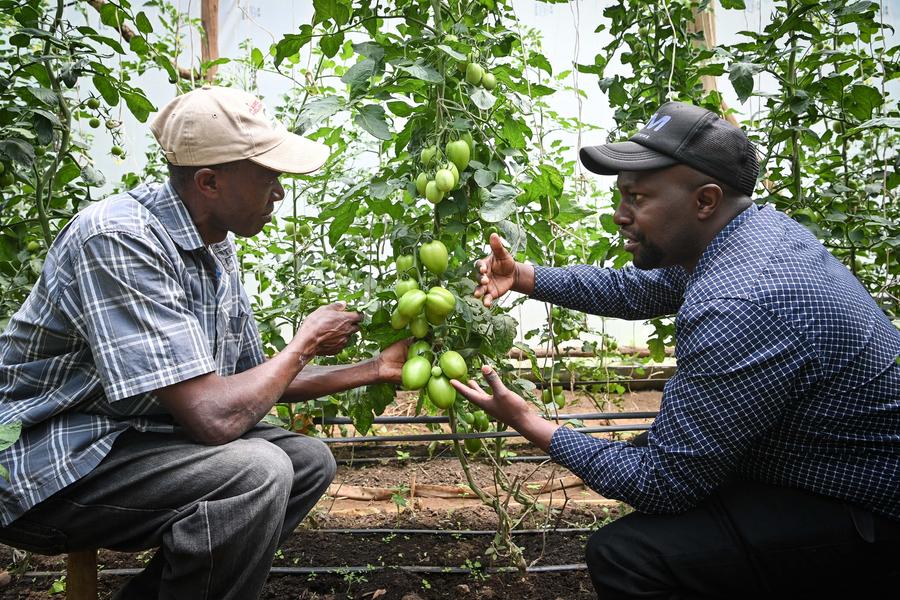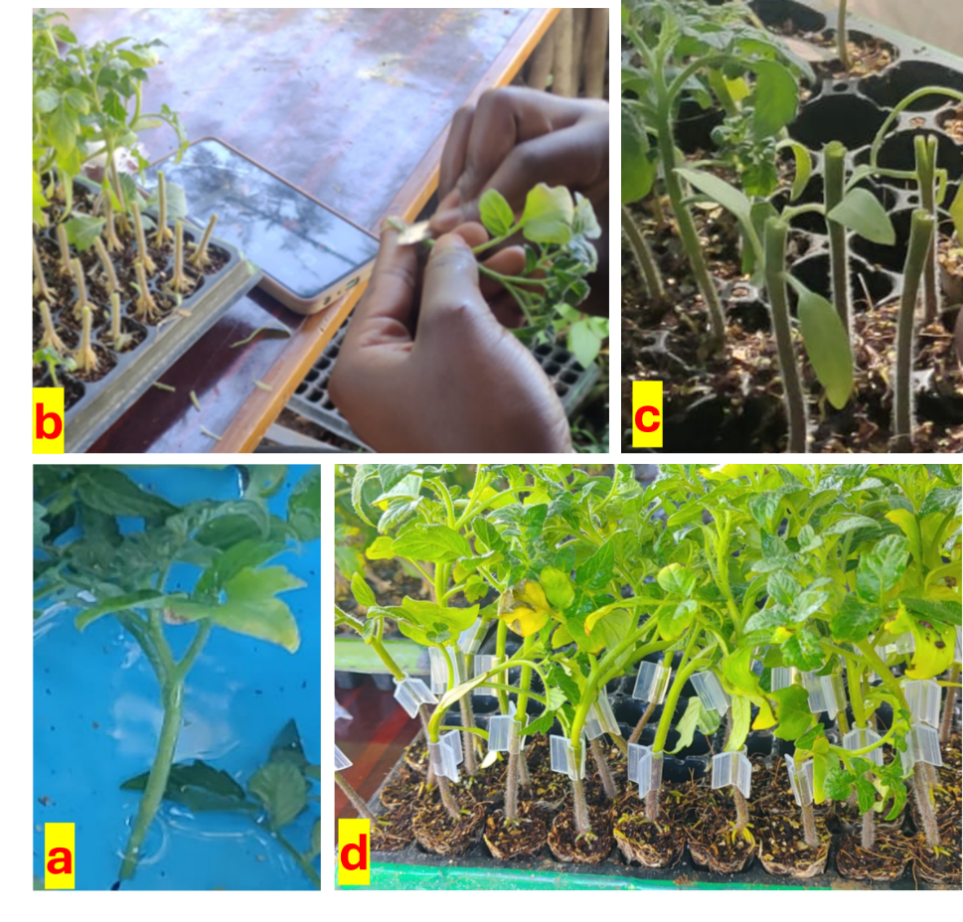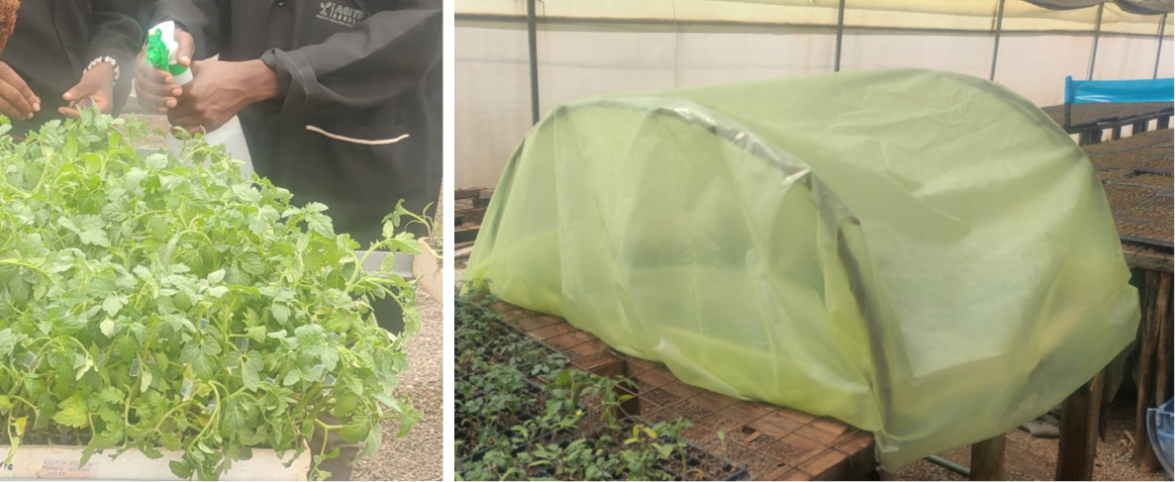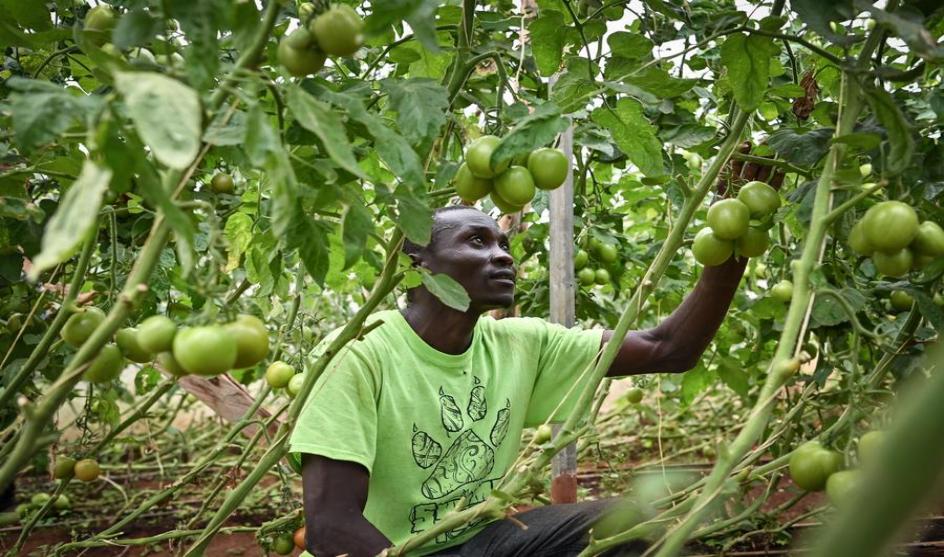
Stephen Githeng'u (R), a horticulture expert at Egerton University, gives guidance to a farmer on the field management of grafted tomatoes at a tomato farm in Nakuru County, Kenya, Oct. 23, 2024. [Photo by Han Xu / Xinhua]
Challenge
Tomato farming in Kenya has long been plagued by bacterial wilt, a soil-borne disease for which no effective pesticide currently exists. This has led many farmers to either reduce or completely abandon tomato production, while some have moved to new areas in search of uncontaminated land. However, as suitable land becomes scarcer, finding a sustainable and long-term solution to this problem is becoming increasingly urgent.
Key challenges include:
• Lack of low-cost ecological solutions for controlling bacterial wilt.
• Soil infestation reduces the availability and utilization of productive agricultural land.
• Declining tomato yields impacts farmer income.
Solution: Tomato Grafting Technology
With the growing demand for tomatoes and increasing pressures from pests, diseases, and climate change, a Chinese grafting technology is emerging as an innovative solution in Kenya. Grafting is a cost-effective and sustainable solution, providing farmers with plants that are not only more resistant to disease but also maintain high fruit quality. This technology has already significantly boosted tomato production on pilot farms, offering local farmers a more sustainable and productive way to grow this essential crop, ensuring more consistent and profitable harvests for farmers.
Tomato seedling grafting involves joining two plant parts — a scion (the shoot of a high-yielding but disease-prone variety) and a rootstock (a hardy, disease-resistant variety). By combining the strengths of both, grafting creates a more resilient plant that can resist soil-borne diseases like bacterial wilt, Fusarium wilt, and nematode infestations. This method has also been shown to improve crop yields in saline soils.
The cleft grafting process involves the following steps:
1. Rootstock Preparation: Disease-resistant and stress-tolerant rootstocks are selected. A precise longitudinal slit of 1–1.5 cm is made down the centre of the rootstock stem to provide a stable base for the scion.
2. Scion Preparation: The scion, chosen for its desirable fruit characteristics, is cut below the cotyledons. Two smooth, tapered cuts (1–1.5 cm) are made on opposite sides of the scion to ensure it fits securely into the rootstock split.
3. Joining and Securing: The scion is inserted into the rootstock, and a silicone grafting clip or tube is used to tightly secure the union. This ensures proper vascular connection between the two parts during the healing process.

Figure 1. Cleft grafting. Preparation of the scion (a, b) and rootstock (c) and clipping of the two sections using silicone grafting clip (d).
4. Healing and Post-Grafting Care: The grafted seedlings are placed in controlled healing environments with high humidity (85–95%) and temperatures between 22–28°C. Regular misting and the use of healing chambers are critical during this stage to ensure successful graft union formation.

Figure 2. Post-graft care: Misting of grafts immediately after grafting (left) and grafts dome-shaped healing chamber (right).
5. Preventing Adventitious Roots: To prevent the development of adventitious roots, which can weaken the graft, the graft union is kept above the soil line during transplanting. Additionally, water and fertilizer are applied directly to the substrate to avoid excess moisture around the graft union.
Results
Preliminary results from field trials with 12 Kenyan demonstration farmers using greenhouse tomato production techniques have shown the following promising outcomes compared to ungrafted tomatoes:
• Improved Disease Resistance: Grafted plants show stronger resistance to soil-borne diseases, resulting in more vigorous growth.
• Earlier Maturity and Extended Fruiting Period: Grafted tomatoes mature earlier and have a longer fruiting period than ungrafted varieties.
• Significantly Increased Yield: Grafted plants have increased yields by over 40%, with some greenhouses reporting yields up to twice that of previous seasons.
• Better Tomato Quality: The quality of tomatoes grown in greenhouses has improved, with a 20% reduction in post-harvest losses.
Lessons Learned
Key lessons from the adoption of grafting in tomato production include:
1. Compatibility is Crucial: Success depends on selecting scions and rootstocks with compatible growth patterns, particularly in terms of stem diameter.
2. Environmental Control is Essential: Proper post-grafting care, especially in the first three days, is critical. High humidity and controlled temperatures significantly increase the success rate of graft unions.
3. Prevention of Adventitious Roots: Keeping the graft union above the soil line during transplanting prevents the development of adventitious roots, which can weaken the plant.
4. Farmer Training is Key: Training farmers in grafting techniques and post-grafting care is vital for the widespread adoption and success of this method, helping them overcome soil-borne diseases and improve tomato production.

A farmer manages grafted tomatoes at a tomato farm in Nakuru County, Kenya, Oct. 23, 2024. [Photo by Han Xu / Xinhua]
Success Stories from the Field
Joshua O. Ogweno, Professor of Horticulture at Egerton University in Nakuru County, Kenya, explains that grafted seedlings benefit from better growth, higher yields, earlier maturity, and an extended fruiting period. This innovation has helped farmers achieve a 50% increase in tomato yields compared to traditional farming methods.
The technology was introduced to local small-scale farmers through a partnership between Nanjing Agricultural University and Egerton University, as part of the project funded by the China-International Fund for Agricultural Development South-South and Triangular Cooperation Facility.
The project, titled Empowering Rural Youth through Innovative Horticultural Solutions in Tomato Value Chain, is being carried out in Nakuru city, about 160 kilometres from Kenya's capital Nairobi. The Confucius Institute of Egerton University invited agricultural experts from Nanjing Agricultural University to Kenya to provide training on tomato seedling grafting technology. From its launch in early 2023 to October 2024, the partnership had trained over 1,000 small-scale farmers and more than 100 technicians, supported by modern Chinese equipment.
According to Stephen Githengu, a horticultural lecturer at Egerton, the project has 15 greenhouses owned by small-scale farmers in Nakuru County who were recruited and trained in the new technology. The first grafted tomatoes ripened late in September 2024, with initial assessments conducted in pilot areas such as Molo, Naivasha and Bahati sub-counties. Githengu also highlighted that the yields have shown that the technology is 99 percent accurate in addressing the challenges facing small-scale farmers.
Esther Wanja, one of the local farmers benefiting from this grafting technology, owns a 50-by-80-meter greenhouse with 400 tomato plants in Naivasha.
"This is the solution we've been waiting for. I'm just harvesting my tomatoes and already I have customers at our local market," she said.
Wanja, a tomato farmer for more than 20 years, said she expects to make a profit of $500 in 2024. "This kind of profit was impossible with our traditional farming practices since we were faced with bacterial wilt diseases that affected our yields' quality, and we were always making losses. But now, the future of tomato farming looks brighter."
Another farmer benefiting from the grafting technology is Willy Gitonga from Bahati. His two greenhouses were selected as demonstration farms for the new technique. He was assigned a technician to ensure compliance with the training instructions.
"We are all familiar with the fact that tomato fruits are incredibly seasonal, and with traditional farming we could only harvest twice per year. But now, with grafting technology, we can plant and harvest throughout the year due to its ability to resist seasonal diseases," he said.
Gitonga also mentioned that the technology helps reduce reliance on costly chemical pesticides and fertilizers, which always eat up farmers' profits.
Prof. Liu Gaoqiong from Egerton University, one of the project team members, said there are plans to expand the technology to other regions in Kenya to improve food security.
"We will demonstrate the technology to more local farmers and extend it to other parts of Kenya. We are also eyeing innovations in the tomato value chain to empower more rural youth and women as a way of creating a decent income," he said.
Materials provided by the work team of the project funded by the China-International Fund for Agricultural Development South-South and Triangular Cooperation Facility.
References:
1. Chinese Tomato seedling grafting technology broadening revenue streams for Kenyan farmers
2. Kenyans harvest hope with Chinese technology

Category
Improving Tomato Yield and Disease Resistance: The Impact of Chinese Grafting Technology in Kenya
Contributor
Improving Tomato Yield and Disease Resistance: The Impact of Chinese Grafting Technology in Kenya
Country
Technical Solution

